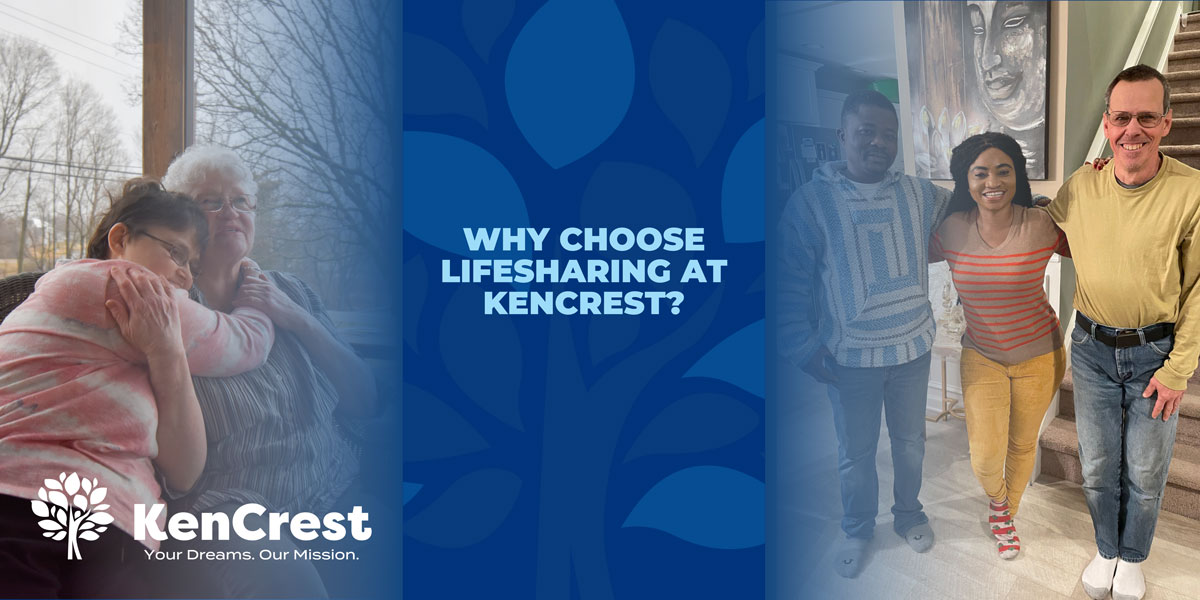Why Choose Lifesharing at KenCrest?

For more than 30 years, KenCrest’s Lifesharing program has connected people with an IDD to uplifting, comfortable families in PA.
By Sydney Kerelo
In 1985, KenCrest introduced its Lifesharing program as an alternative to community, independent, or supported living, encouraging individuals with intellectual and developmental disabilities to live in the community with a host family.
Since its start, KenCrest has matched more than 140 people with local families, some of whom have been together for over 30 years, or in some cases, for life.

One Lifesharing match, Peggy and Leigh Anne, have been together for 14 years after meeting on a KenCrest transportation bus. Peggy was a driver, and Leigh Anne a passenger, and once the two met, they became fast friends, developing a relationship that would last a lifetime. Leigh Anne even lived with Peggy at her home for 13 months while her family searched for housing, and once they found a suitable home, Peggy moved in with Leigh Anne, and she’s been there ever since.
“I am blessed to be involved with her, and I believe that she was brought into my life to make a difference,” says Peggy Horne.
While Peggy and Leigh Anne found each other through KenCrest, other Lifesharing partners are biologically related. George Zimmerman and his Aunt Harriet are Lifesharing partners and have been for quite some time. George grew up in a quiet home with his mom and grandmother before she passed away, and his family debated where he would live next when his Aunt Harriet was introduced to Lifesharing. She knew it was the right fit, and shortly after he moved in, he began blossoming into his own person.
“He’s getting to do many new things [with us],” says Harriet. “He’s gotten to use new tools that he got last Christmas because he was helping Uncle Maylin, and he was enjoying it, so we got him a new tool bag and the start of some tools. He’s now looking forward to helping him build a chicken coop.”
But while Lifesharing is an excellent alternative to residential housing, why would someone become a partner, and why is it so important?
What is Lifesharing?
Lifesharing is more than just opening your home and heart to someone with a disability. It’s about becoming someone’s family, developing enduring relationships, and providing security, support, guidance, and love to someone in need.
According to the PA Department of Human Services, “Lifesharing means living with and sharing life experiences with supportive persons who form a caring household. It is recognized as both a close personal relationship and a place to live. Lifesharers offer individuals the opportunity to be part of a family and to participate in community life.”
KenCrest’s Lifesharing program focuses on the growth and development of each person and finding ways for the individual to achieve their fullest potential through shared life experiences. Lifesharing partners are matched based on an individual’s physical, medical, and social needs, like having access to community activities, events, employment, volunteering, and more.

Why is it so important?
Being a Lifesharing provider is about becoming someone’s caregiver and meeting that person’s needs, physically or emotionally. Whether ensuring they take their medications on time or driving them to a local activity, a Lifesharing provider is that person’s caretaker.
For some people, it’s their first time alone without direct support 24/7, and it can be a scary experience. But when you have a close, familial relationship with the person you are moving in with, it can be less of a frightening experience and more of a new opportunity.
Lifesharing providers help guide their partners towards the best version of themselves by modeling kindness and compassion, teaching tolerance and patience, and encouraging independence.
How do you become a Lifesharing family?
Individuals interested in Lifesharing with KenCrest must complete the Lifesharing Program Interest Form first. Then complete various requirements like the KenCrest-funded background checks, provide proof of a sustainable income, meet the physical health requirements, provide multiple references, and finish the required training.
Once the potential provider completes the program requirements, they will have access to various supports like 24/7 on-call emergency support, ongoing, individualized training, up to 30 days annually of substitute care, team support, person-centered planning, a tax-free monthly stipend, and assistance with medical aid.
